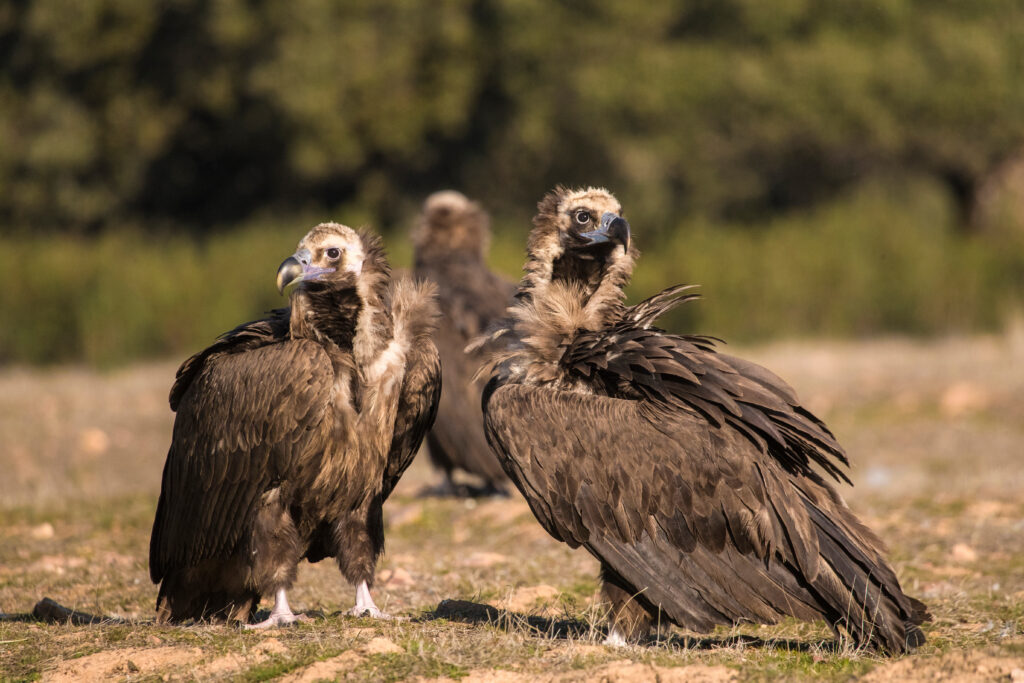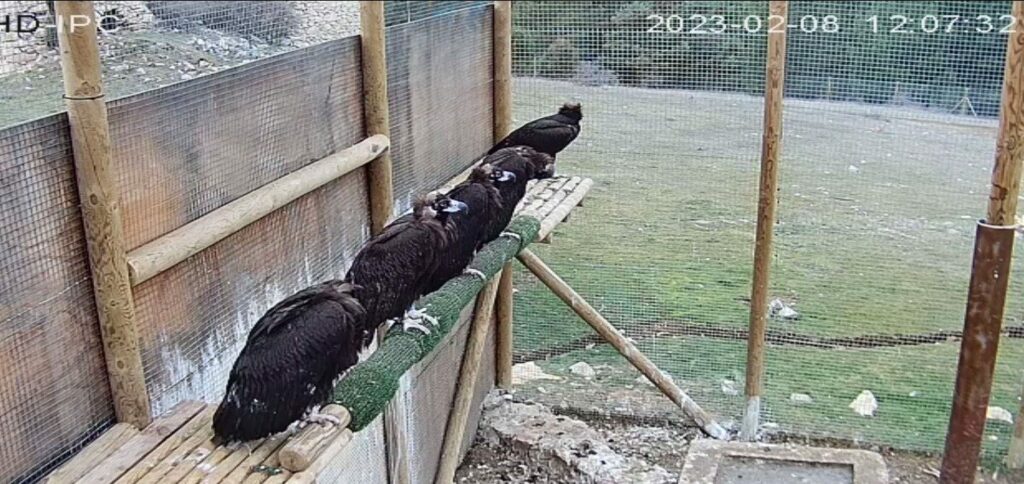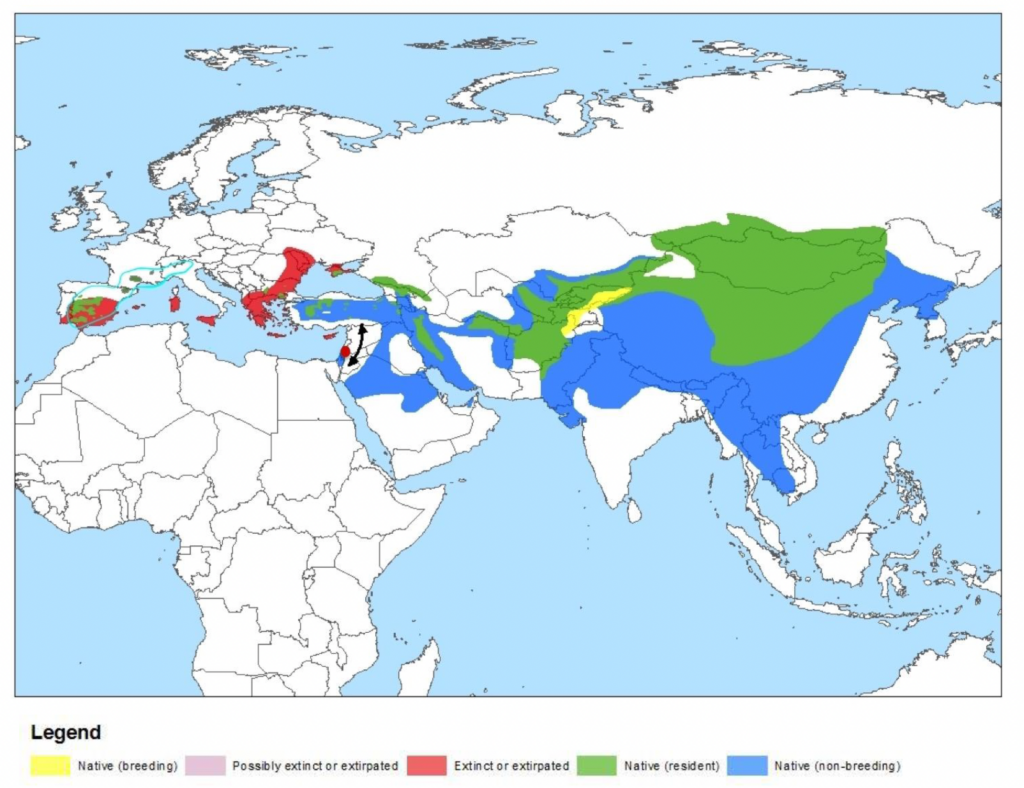Last month, Rewilding Spain released seven Cinereous Vultures (Aegypius monachus) in the Iberian Highlands (Sistema Ibérico Sur) after spending seven months in an acclimatisation aviary. A collective effort to restore this keystone species and re-establish a viable breeding population in its historical range! An initiative promoted by the Regional Government of Castilla la Mancha, with Terra Naturalis and Alto Tajo Nature Park.

Soft release of seven Cinereous Vultures in the Iberian Highlands
After the first release of ten Cinereous Vultures in 2020, seven individuals were released in July this year, all coming from El Campillo Wildlife Recovery Centre. The birds, found in a weak health condition, were fully rehabilitated and transferred to an acclimatisation aviary, where they stood for seven months. Ahead of the release, they were fitted with GPS transmitters. Meanwhile, the birds released in 2020 seem to have moved around the Iberian Highlands, though some vastly explored Spain.
It takes at least four years for the species to reach sexual maturity. With this soft release strategy, which has proven successful in a reintroduction project in Bulgaria, the local team expects the Cinereous Vultures released will choose the Iberian Highlands to breed. Hence, sixteen artificial nesting platforms were installed in trees, and project partners are maintaining six supplementary feeding stations spread throughout the Alto Tajo and Cuenca Mountains to ensure food availability.

Restoring the Cinereous Vulture breeding population in the Iberian Highlands
The largest scavenger birds in Europe, Cinereous Vultures play a fundamental role in maintaining healthy landscapes by preventing the spread of diseases and supporting the vital nutrient cycle. Once common across southern Iberia, the Balkans and several Mediterranean islands, the species was driven to extinction in many regions during the 20th century due to illegal wildlife poisoning and decreased food availability.
Historically, the Iberian Highlands was also a breeding area for the species. Griffon Vultures (Gyps fulvus) and Egyptian Vultures (Neophron percnopterus) are still breeding in the region, as they nest in rocky valleys and cliffs. However, as Cinereous Vultures rely on large trees to build their nests, they are susceptible to changes in forestry practices. The degradation of forested areas, combined with other threats, led to the local extinction of its breeding population.

Cinereous Vulture conservation in Europe: a successful story
Although Spain is home to the largest population of Cinereous Vultures, with estimated 2500 breeding pairs (Population estimates for the five European vulture species 2022, Vulture Conservation Foundation), the species is still considered “Endangered” in the country. Over the last decades, however, successful conservation measures implemented in Spanish regions, such as Extremadura, led to a population increase and enabled the natural expansion of the species to Portugal, where it was extinct as a breeding species. Four colonies have been naturally established over the last decade but are still highly vulnerable. The ongoing LIFE Aegypius Return Project brings together the Vulture Conservation Foundation and several NGOs from Portugal and Spain committed to doubling the breeding population by 2027.
Wild-hatched Cinereous Vultures are also playing a crucial role in reintroducing the species thousands of kilometres away from the Iberian Peninsula. In Bulgaria, the species became locally extinct in 1985 around the Balkan mountains. Thanks to the reintroduction project Vultures Back to LIFE, two regional breeding nuclei were established int he Eastern part, and in 2022 the first wild-hatchling was produced in the Western Balkan Mountains. In total, 72 Cinereous Vultures were transferred to Bulgaria, 63 birds were donated by Junta de Extremadura after rehabilitation at AMUS wildlife recovery centre, and another nine captive-bred in zoos within EAZA’s Ex-Situ Programme, the Cinereous Vulture EEP.
How Rewilding Spain is supporting vulture conservation
The Iberian Highlands (Sistema Ibérico Sur) recently became Rewilding Europe’s tenth landscape. A 500km-long mountain range that encompasses several protected areas, Natura 2000 and Ramsar sites. The committed local team at Rewilding Spain aims to restore ecological processes and boost social-economic development through nature-based solutions.
To bring back the four European Vultures species to the region, they expect to release another 40-50 Cinereous Vultures in the coming years and support the natural expansion of the Bearded Vulture (Gypaetus barbatus). With the support of local partners, they are maintaining feeding stations, implementing nesting platforms and working with hunters to support the transition to lead-free ammunition.

Source: Rewilding Spain



